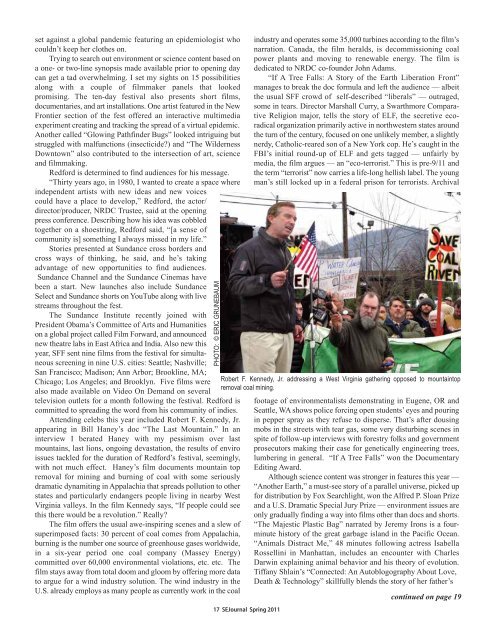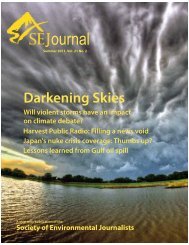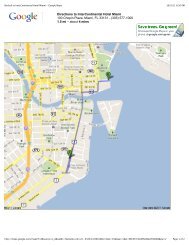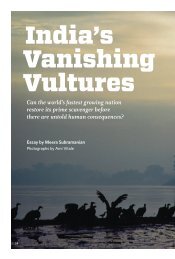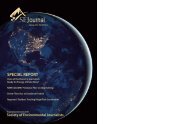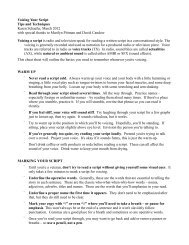PDF Download - Society of Environmental Journalists
PDF Download - Society of Environmental Journalists
PDF Download - Society of Environmental Journalists
You also want an ePaper? Increase the reach of your titles
YUMPU automatically turns print PDFs into web optimized ePapers that Google loves.
set against a global pandemic featuring an epidemiologist who<br />
couldn’t keep her clothes on.<br />
Trying to search out environment or science content based on<br />
a one- or two-line synopsis made available prior to opening day<br />
can get a tad overwhelming. I set my sights on 15 possibilities<br />
along with a couple <strong>of</strong> filmmaker panels that looked<br />
promising. The ten-day festival also presents short films,<br />
documentaries, and art installations. One artist featured in the New<br />
Frontier section <strong>of</strong> the fest <strong>of</strong>fered an interactive multimedia<br />
experiment creating and tracking the spread <strong>of</strong> a virtual epidemic.<br />
Another called “Glowing Pathfinder Bugs” looked intriguing but<br />
struggled with malfunctions (insecticide?) and “The Wilderness<br />
Downtown” also contributed to the intersection <strong>of</strong> art, science<br />
and filmmaking.<br />
Redford is determined to find audiences for his message.<br />
“Thirty years ago, in 1980, I wanted to create a space where<br />
independent artists with new ideas and new voices<br />
could have a place to develop,” Redford, the actor/<br />
director/producer, NRDC Trustee, said at the opening<br />
press conference. Describing how his idea was cobbled<br />
together on a shoestring, Redford said, “[a sense <strong>of</strong><br />
community is] something I always missed in my life.”<br />
Stories presented at Sundance cross borders and<br />
cross ways <strong>of</strong> thinking, he said, and he’s taking<br />
advantage <strong>of</strong> new opportunities to find audiences.<br />
Sundance Channel and the Sundance Cinemas have<br />
been a start. New launches also include Sundance<br />
Select and Sundance shorts on YouTube along with live<br />
streams throughout the fest.<br />
The Sundance Institute recently joined with<br />
President Obama’s Committee <strong>of</strong> Arts and Humanities<br />
on a global project called Film Forward, and announced<br />
new theatre labs in East Africa and India. Also new this<br />
year, SFF sent nine films from the festival for simultaneous<br />
screening in nine U.S. cities: Seattle; Nashville;<br />
San Francisco; Madison; Ann Arbor; Brookline, MA;<br />
Chicago; Los Angeles; and Brooklyn. Five films were<br />
also made available on Video On Demand on several<br />
television outlets for a month following the festival. Redford is<br />
committed to spreading the word from his community <strong>of</strong> indies.<br />
Attending celebs this year included Robert F. Kennedy, Jr.<br />
appearing in Bill Haney’s doc “The Last Mountain.” In an<br />
interview I berated Haney with my pessimism over last<br />
mountains, last lions, ongoing devastation, the results <strong>of</strong> enviro<br />
issues tackled for the duration <strong>of</strong> Redford’s festival, seemingly,<br />
with not much effect. Haney’s film documents mountain top<br />
removal for mining and burning <strong>of</strong> coal with some seriously<br />
dramatic dynamiting in Appalachia that spreads pollution to other<br />
states and particularly endangers people living in nearby West<br />
Virginia valleys. In the film Kennedy says, “If people could see<br />
this there would be a revolution.” Really?<br />
The film <strong>of</strong>fers the usual awe-inspiring scenes and a slew <strong>of</strong><br />
superimposed facts: 30 percent <strong>of</strong> coal comes from Appalachia,<br />
burning is the number one source <strong>of</strong> greenhouse gases worldwide,<br />
in a six-year period one coal company (Massey Energy)<br />
committed over 60,000 environmental violations, etc. etc. The<br />
film stays away from total doom and gloom by <strong>of</strong>fering more data<br />
to argue for a wind industry solution. The wind industry in the<br />
U.S. already employs as many people as currently work in the coal<br />
PHOTO: © ERIC GRUNEBAUM<br />
17 SEJournal Spring 2011<br />
industry and operates some 35,000 turbines according to the film’s<br />
narration. Canada, the film heralds, is decommissioning coal<br />
power plants and moving to renewable energy. The film is<br />
dedicated to NRDC co-founder John Adams.<br />
“If A Tree Falls: A Story <strong>of</strong> the Earth Liberation Front”<br />
manages to break the doc formula and left the audience — albeit<br />
the usual SFF crowd <strong>of</strong> self-described “liberals” — outraged,<br />
some in tears. Director Marshall Curry, a Swarthmore Comparative<br />
Religion major, tells the story <strong>of</strong> ELF, the secretive ecoradical<br />
organization primarily active in northwestern states around<br />
the turn <strong>of</strong> the century, focused on one unlikely member, a slightly<br />
nerdy, Catholic-reared son <strong>of</strong> a New York cop. He’s caught in the<br />
FBI’s initial round-up <strong>of</strong> ELF and gets tagged — unfairly by<br />
media, the film argues — an “eco-terrorist.” This is pre-9/11 and<br />
the term “terrorist” now carries a life-long hellish label. The young<br />
man’s still locked up in a federal prison for terrorists. Archival<br />
Robert F. Kennedy, Jr. addressing a West Virginia gathering opposed to mountaintop<br />
removal coal mining.<br />
footage <strong>of</strong> environmentalists demonstrating in Eugene, OR and<br />
Seattle, WA shows police forcing open students’ eyes and pouring<br />
in pepper spray as they refuse to disperse. That’s after dousing<br />
mobs in the streets with tear gas, some very disturbing scenes in<br />
spite <strong>of</strong> follow-up interviews with forestry folks and government<br />
prosecutors making their case for genetically engineering trees,<br />
lumbering in general. “If A Tree Falls” won the Documentary<br />
Editing Award.<br />
Although science content was stronger in features this year —<br />
“Another Earth,” a must-see story <strong>of</strong> a parallel universe, picked up<br />
for distribution by Fox Searchlight, won the Alfred P. Sloan Prize<br />
and a U.S. Dramatic Special Jury Prize — environment issues are<br />
only gradually finding a way into films other than docs and shorts.<br />
“The Majestic Plastic Bag” narrated by Jeremy Irons is a fourminute<br />
history <strong>of</strong> the great garbage island in the Pacific Ocean.<br />
“Animals Distract Me,” 48 minutes following actress Isabella<br />
Rossellini in Manhattan, includes an encounter with Charles<br />
Darwin explaining animal behavior and his theory <strong>of</strong> evolution.<br />
Tiffany Shlain’s “Connected: An Autoblogography About Love,<br />
Death & Technology” skillfully blends the story <strong>of</strong> her father’s<br />
continued on page 19


